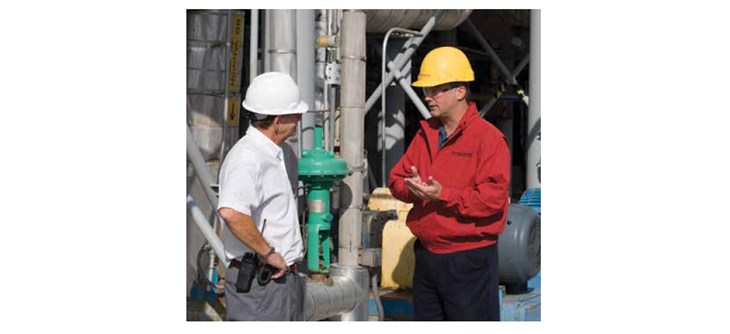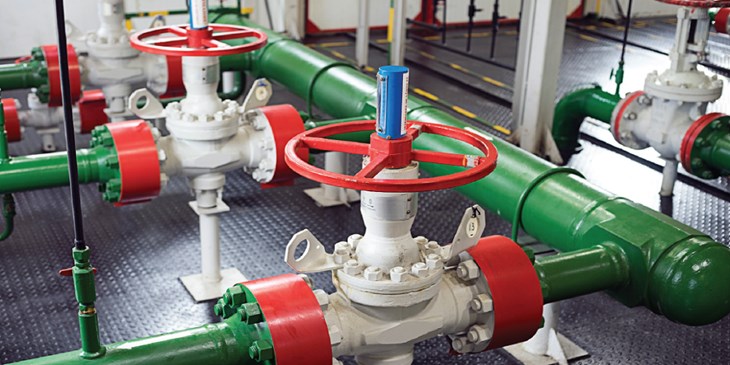By Stephanie Matas
Sealing for Advanced FE Control
According to Hanjra, the Low-E sealing market is very dynamic, and some of the challenges they see in the market today include:
Higher expectations for leakage control.
Since the introduction of the U.S. Clean Air Act of 1970, the requirements for stem sealing in the U.S. contin-ues to become more stringent. “We have gone from a level where 10,000 ppm was acceptable to where some customers are now aiming for 50ppm. These require-ments have been complemented by the latest valve standards and packing standards that are revised every few years,” Mahoney said. “Leakage requirements are kind of like a boa constrictor – once it gets its victim it squeezes, and it never lets go. That is what emission standards are like,” he laughed. “API packing standards right now are 100 ppm, and in some cases only 50 ppm. For new product development projects we currently de-fine Low-E leakage requirements as less than 50 ppm because you need to leave some room in the event standards are tightened.”
Increased durability of sealing products.
“A standard one-year warranty is often not adequate for the Low-E market. A Certified Low Leak Technology (CLLT) such as our 1622 packing, comes with a 5-year Low-E performance guarantee which is standard for this market,” said Hanjra
Ease of installation and maintenance of low-e products.
“When talking with our valve OEM customers, one of the things that comes up is the time it takes to install Low-E products and the resultant reduction in productivity. Most of the time these Low-E solutions require multiple rings to be installed in a precise orientation, and/or or-der, to provide the extremely high sealing performance that is required of these solutions. In the U.S. and other parts of the world, Low-E sealing products are generally installed in areas that are associated with a high level of compliance requirement. Maintenance needs of these Low E sealing products are always high on the list of priority for the end-users,” Hanjra explained.
Stringent product qualification and testing requirements.
Along with market needs, the field of Low-E qualification is evolving continuously. “API 622 test standard for the Low-E packing and API 624 standard for Low-E certified rising and rotating stem valves were released a few years ago. They have now already gone through a couple of revisions. New standards such as API 641 fugitive emissions testing standard for quarter-turn valves was released recently. One must keep abreast with all the latest standards and upcoming changes to these qualification requirements to ensure regulatory compliance,” continued Hanjra.


Sealing at high temperatures to low leakage rates in VOCs is not an easy problem to solve. There are a relatively small group of materials that have the properties needed to effectively seal in a valve stuffing box. The materials need to be chemically inert to handle man different fluid streams. They need to be stable at elevated temperatures and capable of handling thermal cycling. The seal needs to have minimal porosity to ensure low leakage rates, yet it needs to be physically strong enough to minimize extrusion through clearances in a normal valve stuffing box. The materials need to be wear resistant to withstand high cycling environments, and preferably low friction to ensure maximum operability of the valve. “Sealing is a balancing game. No one magic bullet material meets all the requirements for Low-E sealing by itself. All packings are made of a combination of materials, each with their limitations and advantages,” said Mahoney. “The challenge is to find the right balance of materials and best construction techniques to solve as many of these challenges simultaneously as possible.”
Overall, there are many questions the industry is trying to answer about high temperature sealing. What is the highest temperature in low emission applications? How do the valves behave in those types of applications? What temperature does the packing reach when the application sees those higher temperatures? High-temperature Low-E sealing is even a bigger challenge in the case of Control Valves where the cycle count can run in tens of thousands of cycles as compared to few hundreds in an isolation valve.
Current API standards such as API 622 for packings, 624 for rising stem valves, and 641 for quarter-turn, specify testing is to be done up to 500°F in methane. “Cur-rent test standards are limited to 500°F; the challenge is how to test using relevant test methods for temperatures higher than that. Using methane as a test gas is a key component of these test protocols as this is a media that is representative of what the valves in a refinery are sealing. But using methane at temperatures above this poses a significant safety risk. Other test gases are used in other standards, such as helium in ISO 15848-1, but there are significant issues with correlating leakage be-tween the different media and measurement methods,” explained Mahoney.
Chesterton has been active in Low Emissions (Low-E) sealing since the 1990s; before there were standardized test methods to verify the capability of compression packing sets to meet specific VOC leakage rates. When the initial regulations were put into place, there was not a lot of data to validate or quantify leak sources. As field data became more available, end users began to focus on im-proving the emissions rate from valves and connections. End users worked on formulating test methodologies to validate emissions capabilities of various sealing devices. This is where Chesterton’s focus on Low-E sealing began. “We worked with end-users to develop those test methods and implement them into our development process. Those early test methods were used to validate new products for our customers to meet these increasingly stringent regulatory requirements,” said Hanjra. Chesterton’s 1600 packing was one of the first Low-E compression packings developed that met the limits required and was vetted using those initial test protocols.
As time went on, industry standards were developed to establish common test methods that could be used to validate capabilities of compression packings (ISO 15848-1, API 622, etc.); these standards consolidated methodologies and techniques initially developed by end users individually. These industry standards are constantly being revisited and updated. Part of Chesterton’s product development philosophy is to closely monitor and participate in these standard groups to stay abreast of developments and new requirements.
Validation of Products
As standardized testing methods are an essential part of validating new products, Chesterton has invested significantly to develop in-house test lab capacity. This is necessary to ensure that product capabilities are verified and repeatable before submitting to a third party test laboratory for certification. “This also allows us to con duct unique tests for customers looking at new sealing challenges. Currently our test lab is capable of running emissions tests with either methane or helium, both of which are fitted with the latest safety and data acquisition systems,” reflected Mahoney.
Further at Chesterton, all are product related actions are driven by the five-year Product Line Strategic Plan that is in turn driven by market needs or challenges. “We are continually monitoring the challenges that are faced by this market by listening to our customers, regulatory bodies, and making sure we incorporate those in our new product development projects,” said Hanjra.
Product development at Chesterton begins in one of two phases – MVP (Minimal Viable Product Development) or NPI (New Product Introduction). “MVP is essentially concept development, it might not be a product yet, just an idea that is brought forth to a group of engineering experts, scholars, and fellow employees. They weigh in on experiments that test the validity of the material and determine if it shows promise before proceeding to invest the resources to develop it,” said Mahoney. “At this stage, we talk about new technologies, for example, sensors, special coatings, etc. – these ideas are not necessarily linked to one product but may have a broader application and have to be explored further.” Hanjra continued, “Once these ideas are determined as viable, we explore these as business opportunities.”


Chesterton uses a five-step NPI process, for product development.
1. Ideation – Discuss the viability of the NPI project. Does it look like we can do it?
2. Planning – Business development and initial research on prototypes.
3. Verification & Validation – Testing & specification provision. Is everything that was asked for included in the product?
4. Commercialization – Setting up inventory, developing item numbers, finalizing machining, equipment verification.
5. Launch & Post Launch – Products are launched to the target market and then monitored closely for three years after release for quality & consistency. Training of the sales team and target distribution or product is part of this stage.
Hanjra says even though it could be difficult to simulate an actual work environment in a lab, Chesterton wants to be certain its sealing products work in actual work environments, i.e. in cases of high temperature (greater than 500°F) sealing. That is one
challenge that Mahoney’s team is working on: to assure that our products function optimally at high temperatures both in control and in isolation valves, even when there are no clear testing standards to choose from and testing is difficult.
Mahoney says there is an opportunity here, and a void to fill in the market for products in the high temperature category, and Chesterton as a company is well equipped to fulfill that need by developing new products or enhancing existing products.


Chesterton maintains a continuous quality improvement process and encourages safe, environmentally friendly practices wherever possible. “Our environmental team looks at each new product to determine if there is any-thing particularly harmful or dangerous in the manufacturing process, and their opinion holds great weight. Sometimes they will request we not use a particular material because it poses a potential risk for the environment. We review everything we develop and how it increases the safety of not only our employees but also our end users. We never commercialize anything unless we determine that it is safe and upholds environmental standards,” said Mahoney.
One of the key things that sets Chesterton apart is the ability to help in fugitive emissions abatement. “That is also one of the pillars of our overall product line strategy, whether it be through product development or our interactions with the industry and regulatory bodies globally,” said Hanjra. “We make sure we are great environmental stewards by ensuring we uphold proper processes internally, respond to industry challenges, and maintain a high level of expertise for our customers.”
Facing the Future & Regulatory Changes
When asked what the future holds for the industry, a cleaner, more sustainable practices are in mind. “I think the regulations in the future will be more stringent if the past is an indicator of the future. Not just in the U.S., but globally, society has seen a much cleaner environment due to the lockdowns. There are cities where the citizens had gotten used to sub-par air quality—people are experiencing what clean air feels and looks like. Given that, I think once we are through this economic slowdown, everyone will be more focused on clean air, and this will lead to new product technologies to meet the new norms,” said Hanjra.
Mahoney continued, “To Raman’s point, people like cleaner air. There is no need to be emitting methane into the environment if you have seals that maintain leakage well below 100 ppm, and they are not significantly more expensive than technologies of the past. With new technologies, you get immediate results.” Mahoney points out that nowadays there are so many new monitoring techniques, such as drones with Optical Gas Imaging, satellite imaging, etc. that make it easier and more cost-effective to locate emissions leaks. Chesterton aims to ensure there are fewer leaks to find by applying the most advanced Low-E sealing devices available.


